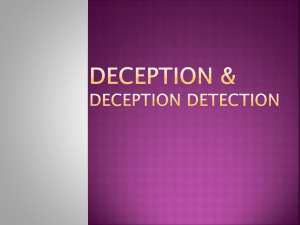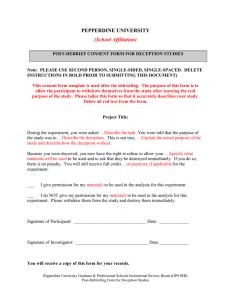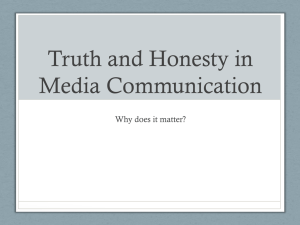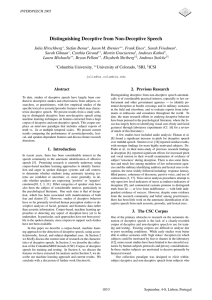Julia Hirschberg Andreas Kathol Stefan Benus Laura Michaelis
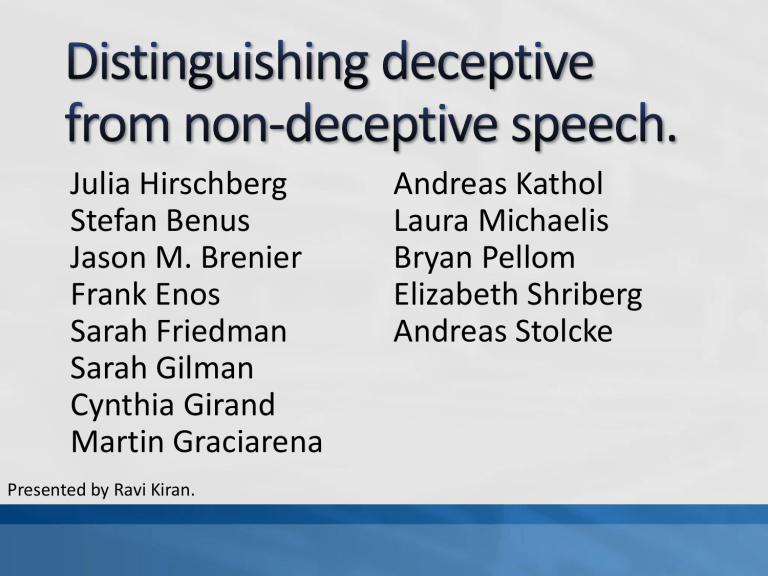
Julia Hirschberg
Stefan Benus
Jason M. Brenier
Frank Enos
Sarah Friedman
Sarah Gilman
Cynthia Girand
Martin Graciarena
Presented by Ravi Kiran.
Andreas Kathol
Laura Michaelis
Bryan Pellom
Elizabeth Shriberg
Andreas Stolcke
Problem.
Solution.
Results.
Conclusion.
Problem Definition.
Applications.
Challenges.
Distinguish deceptive from nondeceptive speech.
Machine Learning techniques.
Automatically or semi-automatically extracted features.
Large corpus of annotated speech.
Government and Corporations.
Law enforcement.
Military tasks.
Insurance companies and others.
Greater impact for common man? Escape into dream-world
Authenticity of bargain market deals.
Antique shop deals.
Typical movie scene: Do you like me?
Task difficulty – How well can we do?
Let’s see a couple of samples.
What is deception? Is it a state of mind?
Causes emotions like fear and elation. Others?
Detecting emotions Detecting deception?
Absence of work on automatic (ML-based) deception detection in Speech.
Detecting deception using Visual and lexical cues.
Statement analysis.
Detecting deception in speech – not automatic.
Absence of labeled Speech Corpora for ML use.
Typical ML-based task.
Labeled speech corpus.
Feature Extraction.
Training Classifier.
Some Challenges.
Method.
Some Challenges solved.
Annotation and Post-processing.
Some interesting questions.
Any new methods designed to collect data for the task might have to consider a few things.
Bogus pipeline effect.
Control of information revealed to subjects before conclusion of experiment.
Other implications for designing experiments?
Deception might be individualized phenomena.
Require both deceptive and non-deceptive samples from each speaker to build speaker specific models.
Other implications for designing experiments?
Deception is not easy, it makes you think. So, why do it? (Motivation plays important role)
High stakes (shame, fear) Good results. But, not possible presently.
Financial reward – Depends on the reward .
Self-presentational perspective to deceive well.
Any others?
What is Deception?
Factually wrong statement.
The world, as you know, will end in 2012.
Statement prompting incorrect deduction or inference.
Equivocal sentence. Example? Common in Courts?
Any other challenges?
32 native English speakers.
Phase 1.
Tasks (activities and QnA) in 6 different areas.
Task difficulty manipulated – 2G, 2P, 2S.
Results compared with “Top Entrepreneurs” profile.
Phase 2.
$100 reward for convincing the interviewer they did better.
Interviewer asked questions (with constraints).
Subjects answered the questions.
Subjects indicated the truthfulness of each answer.
Post-Processing.
Audio data was orthographically transcribed.
Sentence-like units in transcription labeled.
Transcription automatically aligned with
Audio.
Annotation.
Units of data.
Words, Slash Unit, Breath group, Turn unit.
Deception: Little lie and Big lie.
Psychological Motivation? Uses?
Corpus Collection - Post-Processing.
Individualized Phenomenon.
Manipulation of task difficulty.
Deceptive & non-deceptive speech for every user.
Motivation.
Profiles compared with “Top Entrepreneurs”.
Financial reward of $100.
Types of deception.
Self reported Little lie – Factual deception.
Inferred Big lie – Task-oriented deception.
Any Others?
Little vs. Big lie.
Any psychological motivation?
Uses? (hasn’t been used in the ML experiment).
Interviews.
Is the interviewer a trained psychologist?
He selects the questions dynamically. So, a trained person might help?
Effect of the interview-based style on deception.
The interviewer was asking questions that would definitely prompt deception. How does this effect the deception data collected?
Feature selection – How?
Corpus analysis.
Features selected for ML task.
How do we determine what features to explore?
Existing work to the rescue.
Lexical features.
Patterns of word usage.
Filled pauses.
Deception Emotion Word choices ?
Non-lexical features.
Significant increase in pitch for deceptive speech.
Emotions might affect the energy changes.
Deception is a speaker dependent phenomenon.
Any Others?
Lexical features.
Acoustic and Prosodic features.
Word usage patterns – LIWC.
Ratio of Positive emotion words – Deceptive speech > Nondeceptive speech.
Demo.
To explore: Word Count, Causation related items.
Filled pauses.
Correlation with Little Truth > Little Lie.
No significant correlation for Big Truth & Big Lie.
Emotions experienced – DAL.
Pleasantness dimension most promising.
Increase in Minimum pleasantness score Deception.
150 features for each segmented SU’s.
Pitch.
Features extracted on voiced region – 3 forms.
Derived: Max, Min, Mean, Range of pitch etc.
Normalized by 5 different approaches.
Energy.
Raw energy of SU.
Raw energy of voiced region – 3 forms.
Derived: Max, Min, Mean, Range of energy etc.
Durational.
Max and Avg duration in SU – Raw and Normalized.
Lexical, Acoustic, Prosodic and Speakerdependent features used for ML task.
Some lexical features selected.
POS and Word features (presence of cue phrases, verb tense etc.).
Bag of words.
Presence of positive & negative emotion words.
Utterance syntactic question or not.
Number of word repetitions (interviewer’s query).
Disfluency or laughter in phrase.
All non-lexical features (previous slide) selected.
Some Speaker-dependent features.
Subject ID.
Gender.
Subject dependent ratios.
Ratio of filled pauses in Little Truth & Little Lie.
Ratio Laughter in Little Truth & Little Lie.
Ratio of Cue phrase in Little Truth & Little Lie.
Ratio of phrases containing filled pauses to all phrases.
Ratio of phrases containing laughter to all phrases.
Ratio of phrases containing cue words to all phrases.
Any other interesting features?
Input instances were 9491 SU’s.
Labels or Classes were Little Lie and Little Truth.
Ripper algorithm was used.
Outputs were Rules for each Class.
90%-10% Training-Test split.
Baseline is the no. of majority class instances “true”.
Results averaged over 5 trial runs.
All results are in terms of Error %.
Baseline – 39.8%.
Acoustic and Prosodic features only – 38.5%.
Rules based on Energy and F0 features.
Lexical features only – 39%.
Rules based on word repetitions from query, verb tense, presence of filled pauses, presence of word “poor” in SU.
Acoustic and Prosodic + Lexical features – 37.2%
Rules were dominated by Acoustic and Prosodic features.
Acoustic and Prosodic + Lexical features + Speaker
Dependent features – 33.6%.
What about only Speaker-dependent features?
Creation of CSC corpus.
Within speaker deceptive & non-deceptive speech.
Preliminary analysis.
Positive emotion words, filled pauses, pleasantness score are significantly different for the two classes.
Speaker independent & dependent features.
Speaker dependent features are very important.
Greater focus on these techniques in future.
ML based Classification task carried out.
